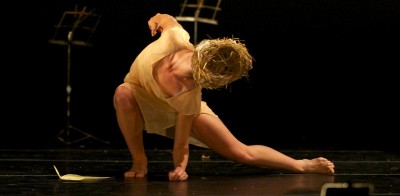By Tori Gottlieb, Special to JTNews
Most people would never imagine that there was ever a time when Idan Cohen wasn’t a dancer. But they would be surprised to find out that the 35 year old, now a world-renowned choreographer, was somewhat of a late bloomer, moving into the world of dance at the age of 19.
Cohen began his lifelong love affair with the arts as a child. A classically trained pianist who played concerts all over Israel, he walked away from the piano at the age of 14 to attend a high school focused on the visual arts.
“I was playing [piano] for eight hours a day,” says Cohen. “It became a struggle. [But] I still knew that I wanted to be involved in art and I wanted to create.”
After graduation, Cohen returned to Kibbutz Mizra, where he grew up. He declared pacifism and was exempted from service in the army, instead opting to volunteer with children. He began taking afternoon dance classes at the kibbutz, and was hired by the Kibbutz Contemporary Dance Company at the close of his year of volunteer service.
Cohen says he was inspired to become a dancer by his sister, Liya, who is now a dance instructor in Israel. “I always looked up to my sister,” says Cohen, whose path to dance belies a family affinity for the art form. “I have to say that I feel that dance and choreography is really the right form of art for me,” he adds. “I’m very happy with my choice.”
Cohen left the Kibbutz Contemporary Dance Company in 2005 to begin creating his own work. His first full-length piece came in 2009 when he choreographed and performed a contemporary version of Swan Lake. He now leads a company with six full-time dancers, and his work has been recognized with awards from all over Europe and Israel, including the 2012 Israeli Ministry of Culture award for young artists.
Since January, Cohen has been working in the United States as a visiting artist, first as an Amherst Fellow at Amherst College in Massachusetts, and most recently as a Schusterman Visiting Israeli Artist at the University of California at Irvine. He plans to present a piece he created during his time at UC Irvine during his performance at the Seattle International Dance Festival on June 14.
The solo piece, which Cohen originally created for dancer Noa Shiloh, is set to “Songs of a Wayfarer,” a cycle of songs by Austrian Jewish composer Gustav Mahler. The lyrics tell the story of a wayfarer whose heart has been broken, and who spends his days wandering the world in search of comfort. “The songs speak a lot about the connection between man and nature,” Cohen says. “The wayfarer struggles to let the beauty [of nature] in. He feels he can only see the pain and hardship that he suffers because of the end of love.”
“Songs of a Wayfarer” is part of a trilogy that Cohen has been working on for the past two years based on the concept of cultural nesting. Cohen was inspired by his grandmother, who escaped from Austria as a teenager in 1938, but worked to maintain the culture she had grown up with throughout her life.
“My grandparents’ house looked Viennese,” said Cohen. “Everything there was almost as if you’re stepping into a time tunnel.” Cohen incorporates this visual into his performance through the metaphor of a bird’s nest, which he says “represents the idea of a home, but a home that is made of fragile objects.”
“We emigrate in the same way that birds migrate,” says Cohen, “but that concept of a home is built of ancient instinct. I play with that concept and with the image of the bird’s nest. At the end of the piece, the bird’s nest becomes a mask that swallows the identity of the dancer who is presenting it.”
Cohen argues that in this way, he is opening the discussion of cultural nesting and how it applies to the identities of Jews and Israelis today who are part of a state that is constantly fighting for its own definition of “home.”
